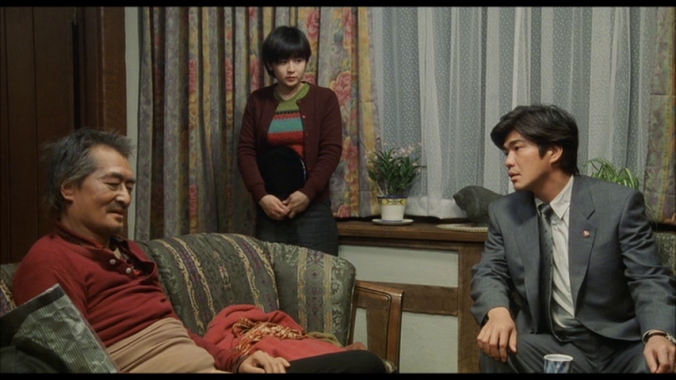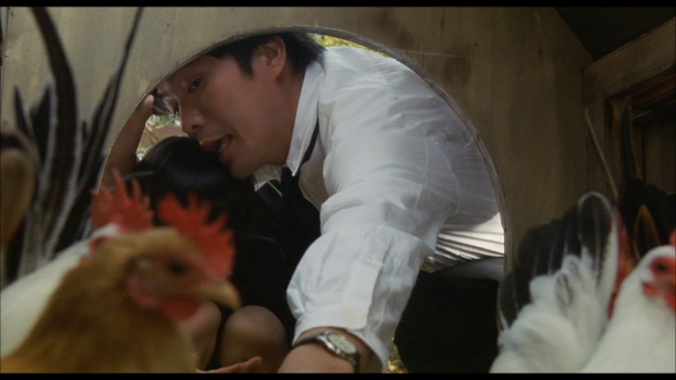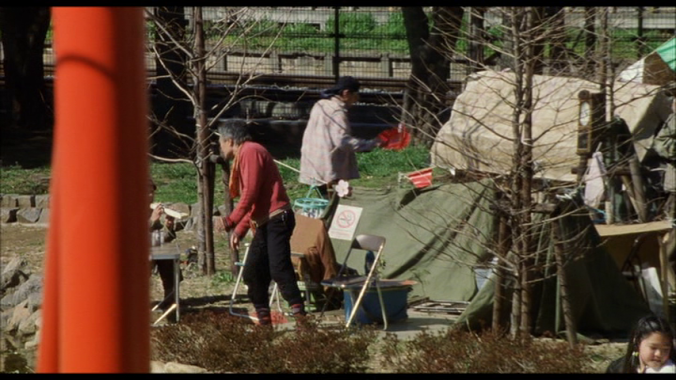 Hiroshi is a happy salaryman with a pretty wife, a young son, and a nice home who has always been told his father died when he was five. One day a tramp stops him on the street and introduces himself as Hiroshi’s father Sasaichi and asks to stay over for a night or two. The night stretches into weeks, while everything Hiroshi has ever believed about his life now comes into question, including the bankruptcy of his employer that leaves him unemployed.
Hiroshi is a happy salaryman with a pretty wife, a young son, and a nice home who has always been told his father died when he was five. One day a tramp stops him on the street and introduces himself as Hiroshi’s father Sasaichi and asks to stay over for a night or two. The night stretches into weeks, while everything Hiroshi has ever believed about his life now comes into question, including the bankruptcy of his employer that leaves him unemployed.
Hiroshi is living with his wife Mizuho, her mother, and his pre-school son Mitsuru, while we later find that Hiroshi’s mother has a cafe/truck stop. She eventually confirms that she had lied and that Sasaichi had deserted them rather than dying, though the two give different versions of the reason. As we might expect, Sasaichi is far from the comfortably bourgeois world in which Hiroshi now lives. He is not quite a real scoundrel but he is a drinker and gambler. As Hiroshi spends more and more time away from home, working or drinking after hours, Sasaichi forms an immediate bond with his grandson. Eventually, he is caught peeping into Mother-in-law’s bath after he has cooked one of Hiroshi’s pet chickens and Hiroshi throws him out. He lives in a homeless encampment in the local park until circumstances bring him back into the household. Hiroshi’s mother steps in to solve the problem by telling them all that Hiroshi is not actually Sasaichi’s son, but a severe cirrhosis attack sends Sasaichi to the hospital before he can leave again.
As the summary suggests, Ah haru is as firmly set in the middle-class family world as an Ozu movie of the fifties, but the problems of sub-titles leave us in some confusion about that world. The movie begins with a family ceremony for a dead man, not a funeral but one of the significant anniversaries of a death observed by Japanese families, but it takes us some time to sort out the dead man was Mizuho’s father. Hiroshi lives in their family home, not in an apartment such as his salary would have provided, and refers to Mizuho’s mother as Mom. Thus, though there is no family business, he seems to have been “adopted” into the family that had no son when he married Mizuho, for the usual tradition is for the wife to move into the husband’s family and care for the husband’s mother. Similarly, the cafe owned by Himiyi is staffed by a young woman who calls her Mom, but when Hiroshi comes to the cafe he has a chat with the woman’s husband, who calls Hiroshi Little Brother. However, he can’t really be the elder son, or Sasaichi would have sought him out for help, we would assume, or Hiroshi would have passed Sasaichi along to him.
While most of Shinji Somai’s films revolved around teenaged alienation of various kinds, Ah haru is unusual in that it is about adults. In the way of the traditional shomin-geki, a great deal is dealt with in a subdued manner, revealed in passing comments rather than arguments or discussions. There is some unspoken tension between Hiroshi and Mizuho – she dreams of being pregnant but tells him not to worry, it was only a dream – and she complains that he only tells her about things when they are over, never sharing concerns when they first appear. Mizuho’s mother mentions in passing that the dead father had eventually come to admire Hiroshi. Mother and daughter call him a “country boy” because he keeps chickens in their yard.
Despite these questions, Ah, haru is one of Somai’s most approachable movies for outsiders, possibly even more so than the farcical Tokyo Heaven. Like the traditional shomin-geki, it is sometimes funny in a chuckle-of-recognition manner and basically warm-hearted without falling into the sentimentality inherent in the situation. This is aided by one of the most unusual scores in a nation that had by now made unusual music scores a feature, most of the music from Yoshihide Otomo sounding as if played on a combo of toy piano, toy marimba, and trombone. Somai uses a blend of his earlier Mizoguchi-like long takes and more international-style cutting inside scenes, even on occasion approaching a real close-up.
The economic “bubble” is collapsing, but Hiroshi refuses to see that his company is in trouble until it is too late and he is left standing on a train platform with no work to go to. Himiyi’s cafe is also floundering. Homeless encampments in public parks are just something that we have never seen in earlier Japanese movies, certainly not since She and He made at the beginning of Japan’s economic miracle. The surge of racism that often accompanies bad times surfaces when a stranger in a suit attacks Sasaichi and his friends who are playing music for donations, telling them to “go back to their own country,” even though there is no indication that any of them are not Japanese. Hiroshi’s past is only alluded to; left alone with a single mother, he somehow managed to go to college but resents that his wife “has never known hardship.” Sasaichi is tracked down by the woman he has been living with but refuses to return because he thinks she is trying to kill him for the insurance money.
Homeless encampments in public parks are just something that we have never seen in earlier Japanese movies, certainly not since She and He made at the beginning of Japan’s economic miracle. The surge of racism that often accompanies bad times surfaces when a stranger in a suit attacks Sasaichi and his friends who are playing music for donations, telling them to “go back to their own country,” even though there is no indication that any of them are not Japanese. Hiroshi’s past is only alluded to; left alone with a single mother, he somehow managed to go to college but resents that his wife “has never known hardship.” Sasaichi is tracked down by the woman he has been living with but refuses to return because he thinks she is trying to kill him for the insurance money.
Nevertheless, the emotional core remains: What does a son owe his father? Does this obligation still hold even after the father has deserted him and his mother? Such stories were common in the movies made just after the Occupation era, when so many children were raised by widows or by women whose men had simply left, unable to cope with the strain of supporting a family, but they had become somewhat more rare as prosperity returned.
Koichi Sato gives a lovely restrained performance as a happy family man whose life is re-written before his eyes so often that he can barely cope with one revelation before the next hits him.  Tsutomu Yamazaki is a charming Sasaichi, also walking a fine line of his own emotions, neither scoundrel nor con man yet thoroughly deserving of the mess he has made of his own life. As Himiyi, Junko Fuji is a real and complex woman, independent, strong, loving, yet playfully devious, suggesting that she could have become a major figure in Japanese films if she had continued to work after the Red Peony era.*
Tsutomu Yamazaki is a charming Sasaichi, also walking a fine line of his own emotions, neither scoundrel nor con man yet thoroughly deserving of the mess he has made of his own life. As Himiyi, Junko Fuji is a real and complex woman, independent, strong, loving, yet playfully devious, suggesting that she could have become a major figure in Japanese films if she had continued to work after the Red Peony era.*
All of the story takes place in spring, as the Japanese title indicates, and the movie is unusually sunny in its visual look for a Somai movie. Spring is a time of renewal and rebirth, but it is not always an easy rebirth. Many plants need to be cut back and many little chicks do not survive, but taken all in all, life does go on. Things may be different, but they still move forward as spring comes around.
* Presumably, her absence from the screen for more than twenty years was due to a decision to be a full-time mother for a daughter and son, both of whom as adults became actors as well, the son following his father’s footsteps into kabuki and the daughter Shinobu Terajima working primarily in film and television.
Pingback: Umbrella Flower / Kaza-hana (2000) | Japanonfilm
Pingback: Tokyo Sonata (2008) | Japanonfilm